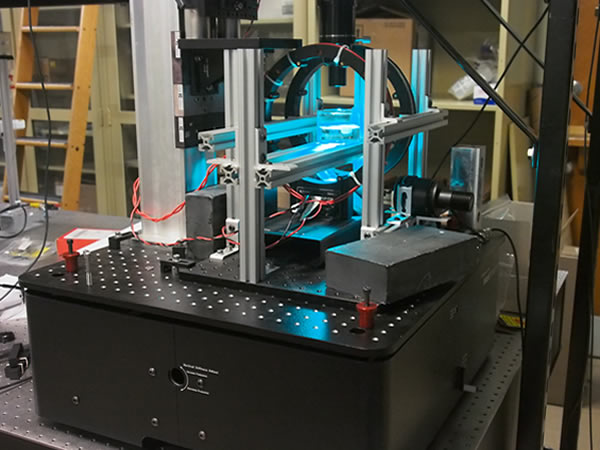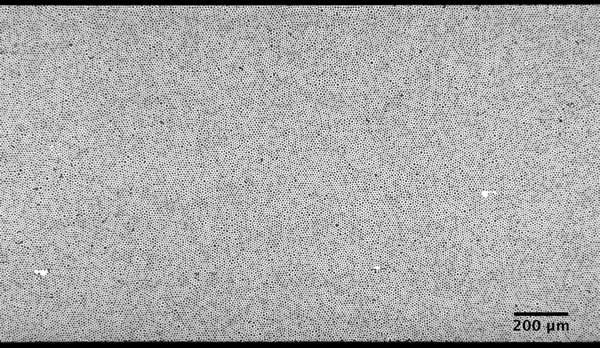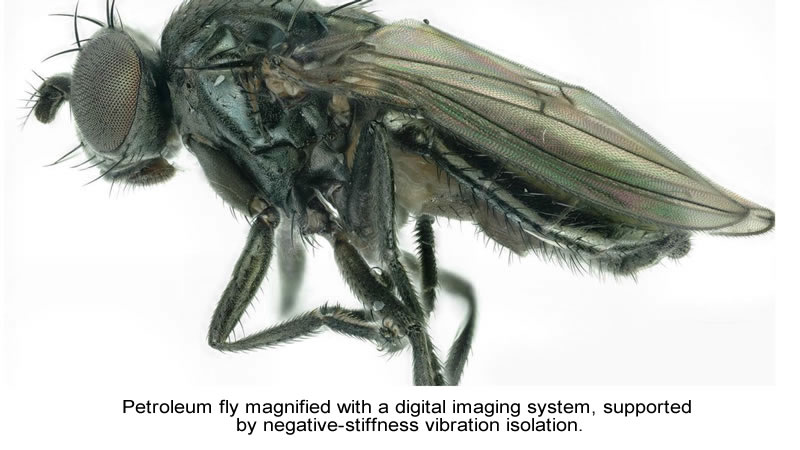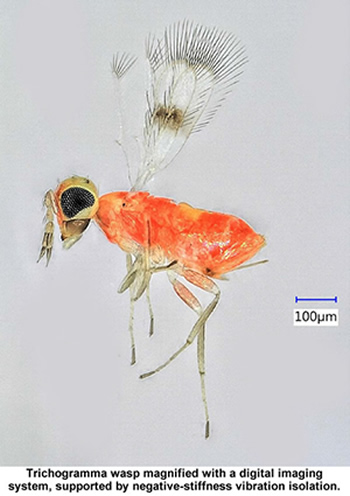|
|
Newsletter October 2023 | Menu of Newsletters
| |
|

This Cal Poly Case
Study was a wnining submission in
Minus K 's 2016
Educational
Giveaway.

Cal Poly’s
2D solid experiment: A self-made interfacial shear rheometer of the two
circular coils that create magnetic forces to deform the sample material in a
glass dish and measured by the microscope suspended above, all sitting on a
Minus K 100BM-1 negative-stiffness vibration isolator.
|
Vibration Isolation Supports the Search
for Memory in Soft, Amorphous Solids
The Soft Mechanics Laboratory at California
Polytechnic State University (Cal Poly is researching soft, amorphous solids
like foams, concentrated emulsions and bulk metallic glasses to determine
whether these materials remember deformations that were applied repeatedly in
the past, and how this information could be encoded in their microscopic
structure and behaviors.
Nathan Keim, Assistant Professor of
Physics at Cal Polys Soft Mechanics Laboratory in San Luis Obispo, has for well
over a decade been conducting research on memory, self-organization and other
non-equilibrium behaviors of soft materials under deformation.
This
includes experimental studies of the mechanisms of plasticity in disordered
solids, and liquid interfaces. With his students, the lab conducts experiments
on interfacial materials, made up of microscopic particles adsorbed at an
oil-water interface, using these two-dimensional systems as models of soft,
amorphous solids like foams, concentrated emulsions and bulk metallic
glasses.
Amorphous solids like foam, sand, and ice cream feature many
particles crowded together. Each particle is fully constrained by its
neighbors, but the material is disordered so these constraints vary greatly,
said Professor Keim. When the material is put under sufficient stress, we know
that local groups of particles rearrange by squeezing past one another, but the
way these microscopic processes organize and give rise to macroscopic behaviors
of the material is still not well understood.
We focus on deformations
that are large enough to cause these rearrangements and change the material,
but too small to disrupt the material completely and cause it to start flowing.
explained Professor Keim. This creates the possibility that the material can
retain a detailed memory of how it was deformed in the past. Exploring how
these memories are stored and how they can be retrieved is an opportunity to
learn more about the mechanisms at play when these materials
deform.
Interfacial Shear Rheometer and Managing Vibrations
To
facilitate this research, Professor Keim and his team have constructed an
instrument, a kind of interfacial shear rheometer, which allows a
two-dimensional amorphous solid to be deformed while measuring its mechanical
properties.
The apparatus uses a pair of magnetic coils to move a
magnetized needle embedded in the material, deforming the material with pN
(piconewton) forces. By simultaneously recording the motion of tens of
thousands of particles in the material, they can connect what is happening on
the microscopic and macroscopic scales a rare and highly desirable ability in
the study of materials.
Since our research basically takes place on the
surface of a dish of water, the experiment is especially sensitive to
low-frequency vibrations that excite surface waves and agitate the material
under study, added Professor Keim. The building where the physics department,
and the Soft Mechanics Lab is housed, has severe vibrations at 5 Hz due to the
many fume hoods in the building, as well as the HVAC system.
When these
vibrations are too strong, they do not just introduce noise, but actually
trigger rearrangements of the particles within the sample material essentially
altering the sample during the measurement. Even when they do trigger
rearrangements, low-frequency disturbances also add noise to the mechanical
measurements and limit the ability to deform the material precisely and
repeatedly
For vibration isolation, the experiments were being conducted
on a tabletop platform resting on passive balloon isolators. But this was not
sufficient to dampen vibrations satisfactorily. So the lab began performing
experiments at night when the chemistry fume hoods were not in operation, which
helped mitigate the problem, but still required considerable computer
processing afterwards to stabilize imaging.
These vibration limitations
had grown more important as we began to examine our materials response when the
exact same deformation is applied hundreds of times, in order to study the
possibility of learning and memory effects, continued Professor
Keim.
Having looked at both optical air tables and active vibration
cancellation systems as potential solutions for the vibration problem, and
determined that neither was satisfactory for cancelling vibrations at very low
frequencies, the lab selected Negative-Stiffness vibration
isolation.

2D solid material
sample: A layer of polystyrene particles at the interface between oil and
water. The black bars at the top and bottom are the boundaries that are moved
to shear the material.
|
| |
Article
continued...
|
|
|
|
The
LC-4
is an ultra compact, low-frequency negative-stiffness isolator. It comes in two
configurations, our low horizontal frequency performance of 1.5 Hz or our ultra
low horizontal frequency performance of 0.5 Hz. Both configurations offer our
signature 0.5 Hz vertical natural frequency.
This low frequency
vibration isolator is for weight loads from 15 to 130 lbs. and 1/2 Hz
performance vertical and horizontal.
LC-4
isolators can be combined into multi isolator systems to support heavier
payloads while taking up very little room themselves. The isolators are
passive, manually-adjustable and require no air or electricity.
More...
- Vertical natural
frequency of 1/2 Hz or less can be achieved over the entire load range.
- Horizontal natural
frequency is load dependent. 1 1/2 Hz (low horiz. freq.) or 1/2 Hz (ultra low
horiz. freq.) or less natural frequencies can be achieved at or near the
nominal load.
- See
performance
for a typical transmissibility curve with 1/2 Hz natural frequency.
Pricing &
specs for LC-4
|
| |
|


Vibration
Isolation Improves Specimen Examination at the
Natural History Museums of
Los Angeles County
The museums'
microscope is supported by negative-stiffness vibration isolation, which
enables precise clarity of specimens being viewed at high magnification and
high resolution
|
The Natural History Museums of Los Angeles County
(NHMLAC), which include the Natural History Museum in Los Angeles' Exposition
Park, the La Brea Tar Pits, and the William S. Harding Museum, is the largest
natural and historical museum in the western United States, holding one of the
world’s most extensive and valuable collections of natural and cultural
history—more than 35 million specimens and artifacts covering 4.5 billion
years of history.
The NHMLAC collections are strong in many fields, but
the mineralogy and Pleistocene paleontology collections are among the most
impressive, the latter thanks to the wealth of specimens collected from the La
Brea Tar Pits located in the heart of Los Angeles. The worlds most powerful
gateway to the Ice Age, the asphalt seeps at the La Brea Tar Pits represent the
only active urban fossil dig site in the world. The site contributes an ongoing
wealth of extraordinary specimens, like saber-toothed cats, mammoths, dire
wolves, and mastodons, as well as the tiny microfossils of insects, plants,
mammals, and reptiles from the last 50,000 years. |
 |
Fundamental to the activities of NHMLAC is
research. Essentially, close examination of these objects, artifacts, and
specimens for the purposes of illustration, preparation of scientific papers
for publishing, and photography for displays within the museum. Much of this
research is conducted with the use of microscopy, viewing specimens at high
magnification and high resolution to observe and examine fine
details.
Researchers at the Natural History Museum in Exposition Park,
for example, are examining the structure of prehistoric fish teeth, minerals,
insects, and other small creatures, said Brian Brown, PhD, curator of the
Entomology Section. Even ancient feathers from 100 million years ago encased in
amber. Amber influences clarity and distorts and changes the viewability of the
feathers. Very high microscopy resolution is needed to examine minute, fine
details from these and other specimens..
|
|
For the examination of its specimens, the museum uses
a digital microscope.
Digital microscopes incorporate observation, image
capture, and measurement capabilities while providing an on-screen interface
for viewing objects. Compared to conventional optical microscopes, digital
microscopy provides superior imaging capabilities. Even at higher
magnification, images are fully focused due to a large, depth- of-field
composition function.
The digital imaging system gives us up to 1,000
times magnification, continued Brown. The microscope allows us to view great
detail and fidelity in our specimens.
Vibration problem
For
several years ambient vibrations severely plagued the microscopes ability to
deliver precision images.
At high magnifications things get very
sensitive, added Brown. This requires great stability. But our microscope is
located on the third floor of the Entomology Section in the museum, in a
cantilevered room extending from the main building. An elevator is located
right next to the room, so we were constantly dealing with vibration issues
that were affecting the quality of our images. We would wait for periods of
relative stability, like between elevator movement, to view images. Even if the
elevator was not running, we would still get ambient vibrations from people
walking around in the department.
Vibration can be caused by a multitude
of factors within a building. Every structure is transmitting noise. Within the
building itself the heating and ventilation system, fans, pumps, compressors,
elevators, doors closing, and footfall are just some of the sources that create
low-frequency vibration that will affect microscopy imaging and data sets.
Depending on how far away the microscopy instrumentation is from these
vibration sources, and where in the structure the instrumentation is
locatedwhether in a basement or in a cantilevered roomwill determine how
strongly the instrumentation will be influenced.
External to the
building, sensitive instrumentation can be influenced by vibrations from truck
movement, road traffic, nearby construction, loud noise from aircraft, and even
wind and other weather conditions that can cause movement of the
structure.
Essentially, we were getting so-so results from the
microscope, and we knew the problem was coming from the ambient vibrations in
the room, explained Brown. We tested an active cancellation vibration isolation
system, but found it hard to set up, and it really did not cancel vibrations
very well. We then did a demonstration of a negative- stiffness passive
vibration isolation system and found it to perform very well.
Article
continued...
|
|
|
|
|
|

 |
|
|
